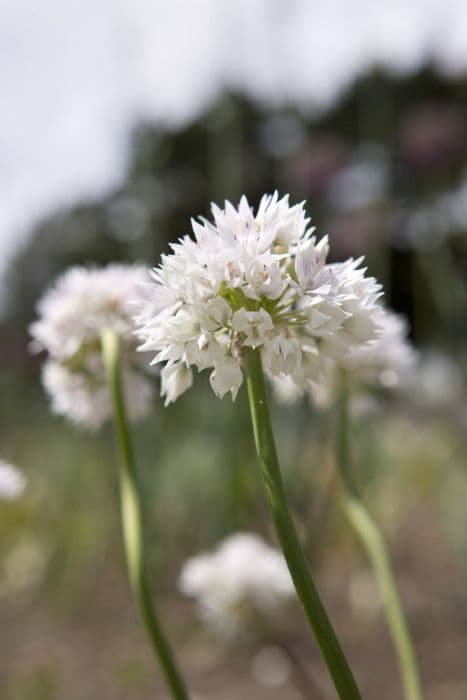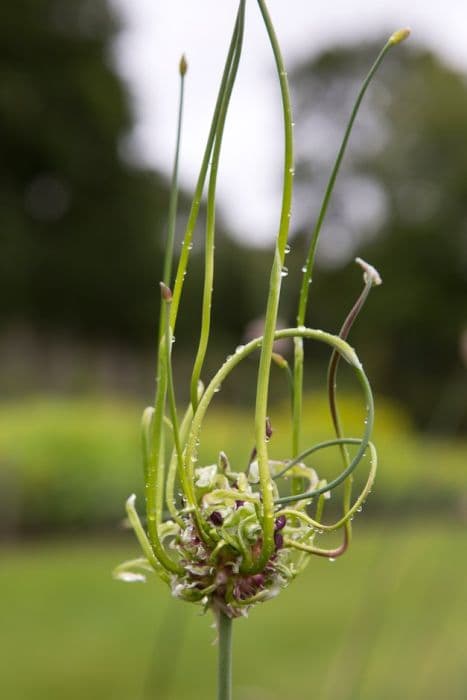Pink Lily Leek Allium oreophilum

ABOUT
The plant commonly known as Pink Lily Leek showcases a charming display with its distinctive floral arrangement. The leaves are slender and typically arch downwards, creating an attractive foliage base beneath the blooms. The flowers are a remarkable feature, with a rich pink hue that can range from soft pastel to a more vivid magenta tone. They form tight clusters of star-shaped blossoms at the top of leafless stems, presenting a striking contrast against the greenery below. These starry clusters create a dramatic visual impact in any garden space, drawing attention with their bright colors and unique shape. The plant possesses an innate grace and can add a touch of elegance to the areas where it's grown. Its flowers are not only visually appealing but also can attract pollinators like bees and butterflies, adding an extra layer of vibrancy to its presence in the garden.
About this plant
 Names
NamesFamily
Amaryllidaceae.
Synonyms
Pink Lily Leek, Ornamental Onion, Mountain Lover.
Common names
Allium ostrowskianum, Allium oreophilum var. ostrowskianum.
 Toxicity
ToxicityTo humans
Allium oreophilum, commonly known as pink lily leek, is not considered toxic to humans. Members of the Allium family, which includes onions, garlic, and chives, are generally considered edible and are commonly used in cooking for their flavor. Therefore, ingesting pink lily leek by humans does not usually result in toxic consequences.
To pets
Pink lily leek, or Allium oreophilum, is toxic to pets, particularly cats and dogs. Members of the Allium genus can cause gastrointestinal irritation and could lead to more severe conditions such as hemolytic anemia if ingested in large quantities. Symptoms of poisoning from Allium species in pets may include vomiting, diarrhea, abdominal pain, lethargy, elevated heart rate, weakness, and collapse. In severe cases, ingestion of Allium species can be fatal, so it is important to prevent pets from accessing and consuming pink lily leek or any other Allium plants.
 Characteristics
CharacteristicsLife cycle
Perennials
Foliage type
Deciduous
Color of leaves
Green
Flower color
Pink
Height
8 inches (20 cm)
Spread
4 inches (10 cm)
Plant type
Bulb
Hardiness zones
4
Native area
Central Asia
Benefits
 General Benefits
General Benefits- Ornamental Value: Allium oreophilum, commonly known as Ornamental Onion, adds aesthetic appeal to gardens with its bright pink flowers that bloom in late spring to early summer.
- Attracts Pollinators: The vibrant blooms attract bees, butterflies, and other beneficial pollinators, supporting local ecosystems.
- Low Maintenance: This plant is known for being easy to care for, requiring minimal attention once established in suitable conditions.
- Pest Resistance: Ornamental Onion is resistant to many common garden pests, reducing the need for chemical pest control.
- Drought Tolerance: Once established, Allium oreophilum has good drought tolerance, making it a suitable choice for xeriscaping and water-wise gardens.
- Deer and Rodent Repellent: The scent and taste of the plant are unappealing to deer and rodents, offering a natural deterrent against these garden intruders.
- Multiplies Easily: It can naturalize and multiply over the years, providing an increasing display without additional costs or effort.
- Companion Planting: Its growth can help to suppress weeds and its strong scent can mask the scent of other plants, providing protection from pests.
 Medical Properties
Medical Properties- Antimicrobial: Allium oreophilum may possess antimicrobial properties due to the presence of compounds similar to those found in other Allium species, which are known to inhibit the growth of certain bacteria, fungi, and viruses.
- Antioxidant: The plant may contain antioxidant compounds that can help protect cells from damage caused by free radicals.
- Cardiovascular Health: Compounds found in this and related species are believed to contribute to cardiovascular health by reducing blood pressure and cholesterol levels.
- Anti-inflammatory: Some Allium species have been shown to have anti-inflammatory effects, which might be present in Allium oreophilum.
- Antidiabetic Potential: There is potential for antidiabetic effects due to the presence of sulfur compounds and other phytochemicals that might influence blood sugar levels.
 Air-purifying Qualities
Air-purifying QualitiesThis plant is not specifically known for air purifying qualities.
 Other Uses
Other Uses- Allium oreophilum, commonly known as Pink Lily Leek, can be utilized as a natural pest repellent in gardens due to its strong scent which many pests find off-putting.
- The plant's vibrant flowers attract pollinators like bees and butterflies, making it a beneficial addition to support local ecosystems.
- In floral arrangements, the striking blooms of Pink Lily Leek add an exotic touch and are often used for their ornamental value and long-lasting qualities.
- The dried seed heads of Allium oreophilum can be used in crafts or as a unique addition to dry flower bouquets for their interesting shapes.
- Garden designers might use Pink Lily Leek as a border plant to create eye-catching designs due to its compact growth and colorful flowers.
- This plant can be incorporated into a green roof design as it is drought-tolerant and adds seasonal interest with its blooms.
- Photographers and artists might choose Allium oreophilum as a subject for its distinct appearance and the way it enhances natural outdoor aesthetics.
- Educators could use the Pink Lily Leek as a tool for teaching botany and plant reproduction, as it is an exemplary model of bulbous plant growth.
- Culinary enthusiasts might use the flowers in a decorative manner to adorn plates or as a natural food coloring due to their pink hue, although care should be taken to ensure they are safe for consumption.
- In permaculture, Pink Lily Leek could be integrated into a garden's design for its beneficial relationship with other plants, helping to form a sustainable, interdependent ecosystem.
Interesting Facts
 Feng Shui
Feng ShuiThe ornamental onion is not used in Feng Shui practice.
 Zodiac Sign Compitability
Zodiac Sign CompitabilityThe ornamental onion is not used in astrology practice.
 Plant Symbolism
Plant Symbolism- Endurance: The allium is a hardy plant with bulbs that can survive harsh conditions, thus symbolizing the ability to endure through challenges.
- Unity: With its spherical cluster of flowers, Pink Lily Leek often stands for the unity and togetherness of all the individual flowers that make up the whole.
- Humility: Pink Lily Leek, despite its ornate flower heads, has a humble appearance when not in bloom, which can represent modesty or simplicity.
- Good Fortune: In some cultures, alliums are believed to bring luck, and thus the Pink Lily Leek can symbolize good fortune.
- Healing: Historically, alliums have been used for their medicinal properties, so Pink Lily Leek might symbolize healing and the protection from diseases.
 Water
WaterThe Pink Lily Leek, or Allium oreophilum, requires moderate watering, and it's essential not to overwater as it may lead to bulb rot. During the active growing season in spring and summer, water thoroughly once a week with one to two gallons depending on the size of your plant and the weather conditions. Ensure the soil has good drainage and allow the top inch of soil to dry out before watering again. Cut back on watering once the leaves begin to die back after flowering, as the plant is going dormant and needs less moisture.
 Light
LightPink Lily Leek flourishes in full sun, which means it should receive at least six hours of direct sunlight daily. The best spot for planting is in an area that is exposed to unfiltered sunlight for most of the day. Though it can tolerate partial shade, the amount and quality of the bloom may be reduced.
 Temperature
TemperaturePink Lily Leek thrives in a wide range of temperatures but prefers the cooler end of the spectrum. The plant can survive minimum temperatures down to about -30 degrees Fahrenheit and can tolerate highs up to 90 degrees Fahrenheit. The ideal growing temperature for this Allium species is between 50 and 70 degrees Fahrenheit.
 Pruning
PruningPruning Pink Lily Leek is largely unnecessary, but you can remove the spent flower stalks after blooming to prevent the plant from self-seeding if desired. Deadheading is generally done in late summer once the flowers have faded. Other than that, no regular pruning is required, simply clean up any dead or yellowing leaves as needed.
 Cleaning
CleaningAs needed
 Soil
SoilPink Lily Leek, or Allium oreophilum, thrives in well-draining soil with a mix of sandy or loamy components and a pH between 6.0 and 8.0. A blend of two parts garden soil, one part sand, and one part compost or well-rotted manure creates an optimal growing medium for this plant.
 Repotting
RepottingPink Lily Leek typically doesn't require frequent repotting; it should be repotted every 3 to 4 years or when it is visibly outgrowing its current container. It is best to repot during the dormancy period after the flowering has finished.
 Humidity & Misting
Humidity & MistingPink Lily Leek tolerates a range of humidity levels; however, it does best in environments with moderate humidity. Avoid highly humid conditions as they can encourage fungal diseases.
 Suitable locations
Suitable locationsIndoor
Provide full sun, well-draining sandy loam soil, and moderate watering.
Outdoor
Plant in full sun, well-drained soil, and water moderately.
Hardiness zone
4-8 USDA
 Life cycle
Life cycleAllium oreophilum, commonly known as Pink Lily Leek, begins its life cycle as a seed, which germinates in cooler temperatures, typically in spring or autumn. The germinated seed produces a bulb, which is the storage organ of the plant, and from this bulb, roots and shoots will emerge. Over the next few months, the shoots grow into slender, grass-like leaves while the bulb develops and stores nutrients. During late spring to early summer, the plant produces a tall flowering stem which bears an umbel of attractive pink flowers; this is the reproductive stage where pollination occurs, often assisted by bees, butterflies, and other insects. After flowering, the plant sets seed, which matures by late summer and is eventually dispersed by wind or animals. The plant then enters a period of dormancy, particularly in colder climates, where the bulb survives underground throughout winter until the cycle restarts with the next growth season.
 Propogation
PropogationPropogation time
Spring to early summer
Propogation: The most popular method of propagating Allium oreophilum, commonly known as Pink Lily Leek, is by dividing its bulbs. Divisions are best done in the fall after the leaves have died back or in the early spring before growth resumes. During these times, the bulbs are dormant, which minimizes stress to the plant. To propagate, gently lift the clump of bulbs from the ground using a spade or fork, and carefully separate the individual bulbs by hand. Each bulb should have a portion of the base plate to ensure that it can grow into a new plant. The separated bulbs can then be immediately replanted at a depth of about 3 inches (roughly 7.6 centimeters) and spaced approximately 6 inches (approximately 15.2 centimeters) apart to allow for adequate growing space. This method is effective as it preserves the genetic characteristics of the parent plant, ensuring a true-to-type propagation.








